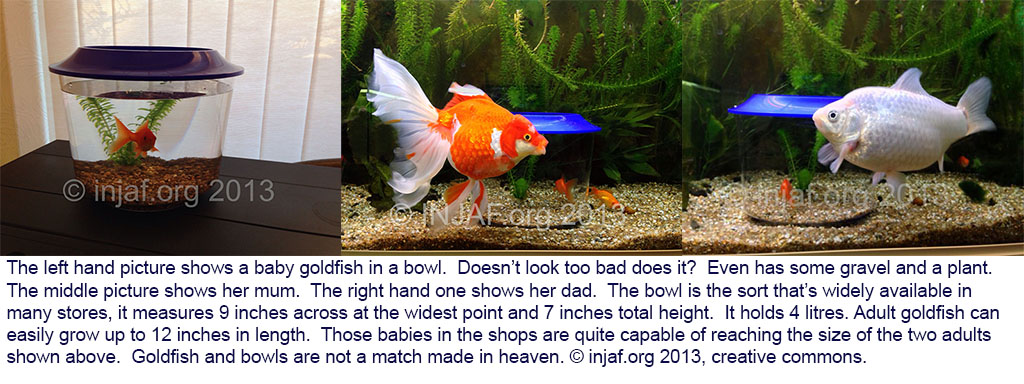What size tank for goldfish is a question that often arises on fishkeeping forums and usually results in a wide variety of opinions and suggestions. It’s something we feel strongly about at INJAF as goldfish are a species that suffer rather more than most when it comes to misconceptions and poor information regarding their care. On a personal note, I’ve been keeping goldfish for many years now and have had the delight of sharing my world with nearly forty of them in that time. I have a particular interest in goldfish behaviour and ‘psychology’; they are remarkably interactive and individual creatures and often exhibit interesting behaviours.
Having taken on many ‘adoptees’ I’ve seen the terrible health problems and stunting caused by other peoples’ poor care and lack of understanding of their goldfishes’ needs. I’ve also been fortunate to have been given goldfish who grew into stunning, and very large, adult fish. I’m hoping that my experiences of the problems caused by inadequate accommodation, and my experiences of keeping full grown adult goldfish, will help others understand the needs of these large fish and help avoid heartache.
I cannot stress firmly enough that you should not believe the ‘grow to the size of the tank’ myth. There is a lot of out of date thinking surrounding goldfish and it’s high time they were given the understanding, recognition and respect that they deserve. Poor accommodation and inadequate care can contribute to them failing to reach their true potential, but it is unacceptable to deny an animal an appropriately sized home, and the right amout of food, in order to keep them small.
The difference between common or singletail goldfish, and fancy goldfish
Different tank sizes are often quoted for common or singletail goldfish, and fancy goldfish. Goldfish can be divided into two broad types; singletails (often referred to as commons) and fancy goldfish. A common or singletail goldfish has a single caudal (tail) fin and elongated body shape; the ‘traditional’ style of goldfish. Fancy goldfish have been line-bred to develop particular body shapes and usually have a double caudal (tail) fin as well as a variety of other physical traits such as headgrowth and oversized eyes. They are likely to have much more rounded and compact body shapes.
Goldfish tank size calculations
It’s not uncommon to see 100 litres, or thereabouts, quoted as the minimum for one goldfish, with varying amounts of additional litres for additional fish. This volume is nowhere near sufficient for a single fish and the dimensions of the tank will be inadequate; the average 100 litre tank is approximately 90cm x 35cm x 30cm.
The ‘six times the length‘ rule is a good one for goldfish as it provides them with adequate swimming room and water volume. It’s the maximum potential adult size of the fish that should be multiplied by six, not the baby size at which you buy it.
The dimensions of the tank are very important, and it’s the dimensions that will dictate the minimum volume for one fish, let alone more. It’s important to look at the bigger picture of goldfish requirements and really start to understand how these fish work, how they behave, their physical and biological characteristics, their need for an enriching environment and their need for social interaction. By understanding the fish, we are better able to see why they need the tank sizes they do.
Why are the tank dimensions so important?
Let’s take a look at some of the points to consider when choosing a tank size for goldfish.
Potential adult size
A fully-grown fancy goldfish can easily reach 30cm long and 30cm tall or more (including fins and tail), with a body the size of a grapefruit and weight approaching half a kilogram. Shorter finned varieties may have less total length, but will still have large, bulky bodies. Taking this adult size into consideration, we can already see that a 100 litre tank of 90cm x 35cm x 30cm will barely allow an adult fancy to turn around.
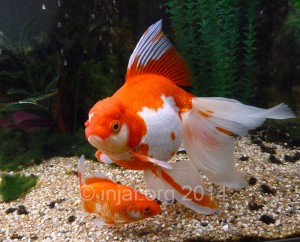
Common goldfish can reach larger sizes; at least 30cm in length, and often longer, especially for long finned versions like comets. They have very deep, wide bodies and can gain a lot of bulk. They can get close to a kilogram in weight, or more.
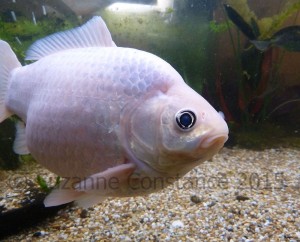
Howie isn’t some sort of special giant goldie, he’s just a normal goldfish that’s grown to the sort of size that they grow to. The photo of Swimmie, shown below, was sent to us by a lady in the US.
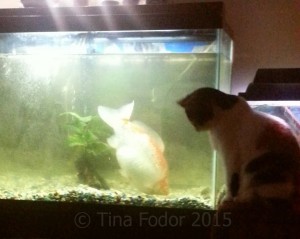
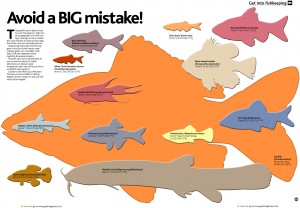
Reproduced with kind permission of Nathan Hill and Jeremy Gay of Practical Fishkeeping Magazine.
Swimming abilities
Fancy goldfish tend to have compromised swimming abilities due to long fins, rounded bodies, heavy headgrowth, poor vision (those googly eyes!) and compacted body shapes. They are not very nimble and need a large turning circle with plenty of room to manoeuvre. Many fancies are not fast swimmers but they still need plenty of room to cruise about and turn easily. This means they need a tank with a large footprint just to have enough room to swim about comfortably.
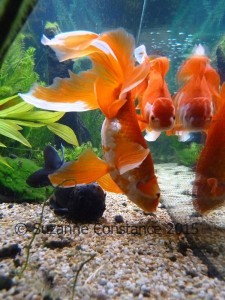
Common goldfish are more nimble than fancies but their overall size still means they can’t turn on a sixpence. They’re almost the white van of the fish world, big, chunky, goes on forever, but can’t turn around in a country lane. Commons are rather more athletic than fancies, and can get up a good speed when they want to. Certain varieties like Sarasa comets are incredibly energetic and zip about at full speed like, well, like comets! Singletails need a very long tank in order that they can really stretch their fins and charge about without knocking into things, or colliding with the sides of the tank.
Surface area
A large footprint translates to a large surface area. This is important for goldfish as they need a good level of oxygen in the water and a large surface area will better enable this. The surface of the water is where gas exchange takes place; the larger the surface area the easier it is for oxygen to get into the water, and for carbon dioxide to get out. Goldfish with heavy headgrowth don’t always have very efficient gills, especially if the growth is also over the gill covers. This means they can sometimes struggle for breath a little, so they really benefit from a well-oxygenated tank.
Bioload
Generally speaking the larger the fish the more waste it will produce. Fish excrete waste through their gills, as well as faeces. This is often referred to as ‘bioload’, or biological load. A fish with a high bioload will need a large body of water and large filters to dilute the waste and house enough filter bacteria to process that waste safely. Goldfish have a high bioload as they are large fish that produce a lot of waste. They eat a lot, and are often caused health problems by well-meaning owners who are so concerned about not over-feeding them that they are very often under-fed instead.
Goldfish are social fish
Goldfish should not be kept alone as they are social fish and benefit from company of their own kind. They are ‘social shoalers’ or ‘loose shoalers’. They don’t need to shoal for the same reasons as sardines for example, but they do like company and will often gather together if they are a bit unsure of something, for example at water change time, or if they’re feeling a little under the weather.
They are remarkably tactile fish and often sit close together, or swim around each other and waft their fins over each other. I’m not talking about spawning behaviour here, this is just friendly ‘alright mate’ behaviour, like a shake of the hand or a clap on the shoulder. If one isn’t feeling too lively the others will sometimes sit with it, or pay it a visit every now and then to check up on it. They often like to sleep in a group too. Company helps them feel secure, and gives them some social interaction.
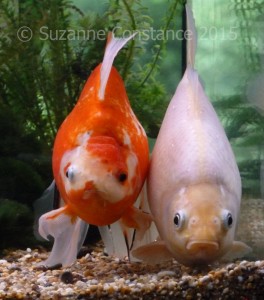
This means that any tank needs to be able to house at least three fish at maximum potential size. Keeping two isn’t unreasonable, but they do seem to benefit from larger groups. It’s important to consider how easily three, four, five fish each 30cm long and the size of a grapefruit would be able to swim around without struggling to manoeuvre around each other.
Feeding time with a group can be quite a scrum so there needs to be enough room for them to shove each other around and grub about. Whilst they like company they don’t like being crowded. They’re not aggressive fish but they can get irritable with each other, and competitive over food if there are too many fish in the tank.
If you have males and females they can get very boisterous and need space to be able to get away from each other as well as having room for spawning behaviour, which can be quite rough.
Space for decor
Goldfish like decor as they are intelligent fish and benefit from a nicely enriched environment. The tank needs to have enough room for suitable décor, such as bogwood and plants, without compromising swimming room. Goldfish benefit from a good airstone as this improves aeration, helping oxygenate the water. As mentioned earlier, those with a heavy headgrowth benefit in particular from good aeration. There needs to be room for a good sized airstone or two without turning the tank into a whirlpool and subjecting the fish to the ‘washing machine effect’.
Lifespan
Common or singletail goldfish can easily live in excess of twenty-five years while fancy varieties should live at least ten to fifteen years. They’re going to be spending a long time in a tank so it needs to be big enough to provide enrichment, things to do (décor to play with, plants to swim around in and snack on) and keep them interested for many years. Spending two decades in an environment that’s too small and has nothing to interact with will not be a pleasant experience.
What size tank do goldfish need then?
At least 120cm x 50cm x 50cm should be the very minimum for fancy varieties, while commons/singletails should not be housed in anything less than 200cm x 60cm x 60cm. Commons/singletails should ideally be kept in large outdoor ponds and not in aquariums at all. Shallower accommodation is suitable as long as there is sufficient depth for an adult fish to upend itself completely as it will when grubbing around in the substrate for food. Any reduction in volume due to lack of depth should ideally be compensated for with increased width or length.
This gives them a reasonable footprint for when they are adults, and gives them a reasonable volume of water. They will have room to manoeuvre properly, space for décor, they will be able to have companions, and will be able to exhibit a fuller range of goldfish behaviours. They won’t be stressed, cramped or alone.
But the fish are only an inch long! They’ll look ridiculous in a tank that size!
They might be inch long babies when you buy them, but they’ll soon grow. It doesn’t take long for a well cared for goldfish to start reaching large sizes. The last goldfish fry from my own fish were four inches long before they were twelve weeks old.
The following picture is from toto691, a member of the Practical Fishkeeping forum. toto’s fish were babies when first purchased but after eighteen months were significantly larger and heading towards adult size. Their tank was 150 litres and toto was moving them to a bigger one.
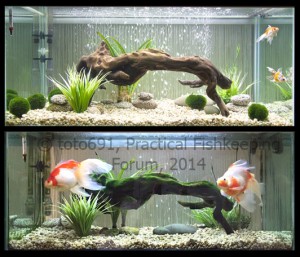
It’s so much better to get the right tank from the outset. You may have every intention of upgrading as required when you start out, but unforeseen circumstances can affect anyone and you may find you are unable to upgrade when you intended. Getting the right sized tank from the outset saves trying to guess when the fish need an upgrade, it will save the risk of causing ill health to your fish by not upgrading the tank when the fish need and saves the huge amount of effort involved in moving a set up from one tank to another. It also saves a lot of money as you only have to buy one tank and one lot of equipment.
If they need such big tanks, why are goldfish shown on the boxes and marketing material for small tanks?
Many small tanks are sold as ‘starter tanks’ and they are really only suitable for a few weeks, months at most, for a goldfish. At INJAF we’d very much like to see packaging and marketing materials give a far more realistic idea of what sort of set up the tank would successfully support long term. We feel it’s irresponsible for manufacturers to continue giving well-intentioned customers the impression that their small tanks are suitable for the goldfish which are all too often pictured on the box. No one would expect a dinky little puppy collar to fit a fully-grown dog.
But when I asked on a fishkeeping forum I was told I was mad to want such a big tank for goldfish
This is why we have a list of recommended forums. We are confident that these forums will not give you inappropriate or inexperienced advice. Try to get advice from people who have experience of keeping fully-grown goldfish. A lot of people don’t really believe how big they can get because they’ve never seen a fully-grown adult. Once you’ve seen one, you’ll soon realise why they need big tanks!
But my friend kept a goldfish in a small tank and it was fine
The definition of ‘fine’ is the key here. A goldfish should grow to about 30cm in length, and live well over a decade. Due to the many misconceptions about goldfish, a lot of people think their fish is fine if it grows over two inches and lives longer than two years. There are some goldfish that have lived a long time in a small tank, but these are the exceptions to the rule.
The fish shown below was called Jerry. He was kept in a bowl, and then a small tank for four years because his owners didn’t understand that he needed a bigger home. This picture was taken shortly after I brought him home. He was badly stunted, deformed and malnourished. He died at four years old, his health problems were too severe for him to recover from. I’m just pleased I was able to give him four months in a comfortable, peaceful home.
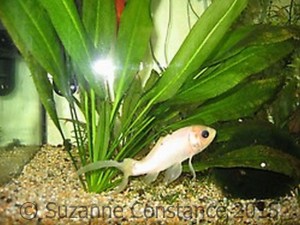
In 2014 there were approximately 20-25 million fish being kept in homes in the UK (PFMA Pet Population Survey 2014). It’s not known how many of these are goldfish, but it’s safe to say that goldfish make up a good proportion of that number. Considering then, that there are hundreds of thousands of goldfish being kept in the UK, the fact that old goldfish are considered newsworthy sends a strong message that the majority of goldfish are not getting old. If every single goldfish in the UK lived to the ripe old age it should, there would be very few still being sold as the market would have reached saturation point and everyone would still have the ones they bought ten years ago.
But the shop staff said …
This one is a bit of a minefield. As mentioned earlier, there is a lot of out of date thinking about goldfish, and sadly this is sometimes the case in shops. While most shops are responsible, and many are trying to move away from advocating goldfish for small tanks, there are still some which have yet to catch up with best practice.
The photos below were posted on Practical Fishkeeping forum and show the goldfish section at a Maidenhead Aquatics and a Pets at Home store. Reproduced with kind permission of the forum members.
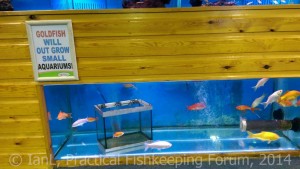
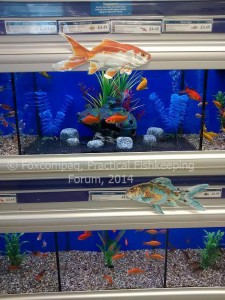
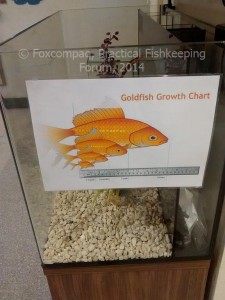
The goldfish growth chart is available from fishkeeping.co.uk.

The best advice we can offer here is to do your research fully and trust your own judgement. If you think, having considered all the points raised above, that a tank is too small, or that X number of goldfish will be too many for it, then stick to your guns. Your fish will thank you for it.
Further reading
Do fish grow to the size of their tank?
Understanding fish stocking guides
Tankbusters
Just starting out? Don’t buy a bowl! Nathan Hill, Practical Fishkeeping
Goldfish 101: Goldfish May Be Popular, And They May Be Cheap, But That Doesn’t Make Them Easy Aquarium Fish, Dr Neale Monks, wetwebmedia.com Dr Monks writes for various aquatic magazines
How to get fancy with goldfish, Practical Fishkeeping’s George Farmer sets up an aquascape for goldfish
Fancy goldfish, Andy Gordon, fishtanksandponds, Andy Gordon has forgotten more about goldfish than most people ever know! He’s written about and photographed fish for numerous magazines
How to tell if your goldfish is a male or female
PDF of goldfish infographic
Author: Suzanne Constance
Photographs: courtesy of Suzanne Constance, PFK forum members toto691, IanL and Foxcompaq

